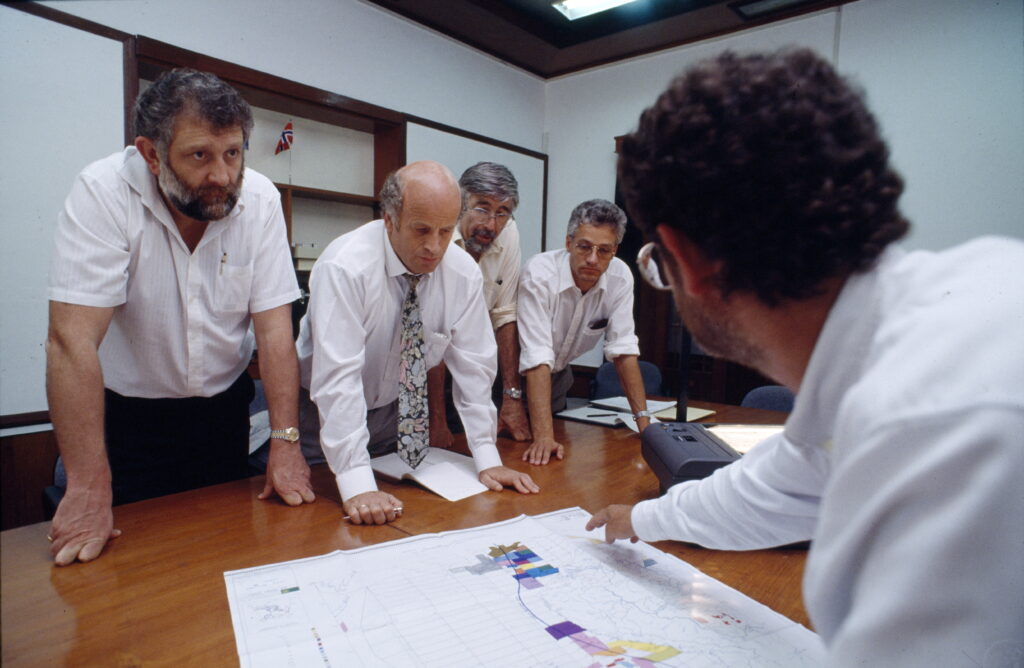Joint venture with BP in Vietnam

In addition to involvement in the socialist republic of Vietnam, Statoil secured participation in licences off Angola, Nigeria and China as well as for exploration in the Soviet Union.[REMOVE]Fotnote: Annual report, 1990, Statoil.
Important national project
With 97 million inhabitants in 2020, Vietnam is the 13th most populous country in the world. After lengthy warfare, its northern and southern sections were united in 1976. The country was then mired in poverty. In 1986, the ruling communist party changed its economic policy and began to introduce a “socialist-oriented market economy”. BP established an office in the capital, Hanoi, which stands in the northern part of the country, where Statoil also secured premises for its representatives.
The relevant exploration targets for oil and gas lay off Vietnam’s south coast, and Statoil secured 13.33 per cent in four licences covering seven blocks in this sea area.[REMOVE]Fotnote: Hatlestad, Helge, 2021, Femti år med oljeproduksjon. Min historie, privately published: 187. In addition to BP, its partners in the acreage were two other state oil companies – Vietnam’s own PetroVietnam and India’s ONGC.
Following geological surveying, three wells were drilled during 1993 in the Saigon Basin and gas was proven in block 6/12.

Two further promising gas discoveries – Lan Tay and Lan Do – were made during 1995 in the Nam Con Son Basin. Opportunities for finding additional reserves which could be tied in with the other discoveries were then explored.[REMOVE]Fotnote: https://www.nb.no/items/fd4536f057ed98964a299bc491cf30e5?page=39&searchText=.
However, a key question was where the gas might be sold. Efforts to establish a domestic market for this resource were now given high priority.[REMOVE]Fotnote: Annual report, 1995, Statoil. Before the discoveries could be brought on stream, a gas infrastructure needed to be established in Vietnam.[REMOVE]Fotnote: Annual reports, 1993 and 1994, Statoil. That called for close collaboration with the Vietnamese government. A pipeline landfall was to be located south-east of Ho Chi Minh City, the country’s biggest urban centre. After negotiations, it was decided that the terminal would be supplemented by a gas-fired power station and a fertiliser factory.[REMOVE]Fotnote: Annual report, 1997, Statoil.
The government approved the BP/Statoil alliance’s gas development in 1997 as one of the country’s five most important national projects. That was “a breakthrough for us”, said Tore Sund, Statoil’s Vietnam manager. A total of USD 1.5 billion was to be invested in developing the offshore gas fields, the 400-kilometre pipeline to land, and the onshore facilities.[REMOVE]Fotnote: Statoil Magazine, “In Vietnam’s top five”, no 3, vol 19, 1997. Statoil had a 16.33 per cent interest in the pipeline, where its partners were BP and PetroVietnam.[REMOVE]Fotnote: Hatlestad, Helge, op.cit

Strategy shift
BP and Amoco merged in 1998, when oil prices had slumped. All agreements in the BP/Statoil alliance were terminated.[REMOVE]Fotnote: Statoil Magazine, “Alliance seeks new framework”, no 4, vol 20, 1998. In the short term, this had no effect on the collaboration in Vietnam. BP and Statoil continued negotiating development solutions and gas sales agreements – including pricing. That took time.
A development decision for the Nam Con Son project was taken in June 2000, covering Lan Tay and Lan Do, the pipeline to land and the terminal. All principal agreements for this scheme were then signed with the Vietnamese authorities, and Lan Tay was due to come on stream in the fourth quarter of 2002. Where Statoil was concerned, its part of the job was thereby done.
After the 1998-99 oil price slump, the company’s strategy was “a more focused Statoil”.[REMOVE]Fotnote: Annual report, 1999, Statoil. Participating in the Vietnamese gas field development, where BP was the operator, no longer fitted in. So Statoil resolved to sell its share of Nam Con Son, even though all the agreements with the Vietnamese government were in place, and wind up its operations in the country. The company’s presence in Vietnam therefore followed more or less the same course as its Thailand involvement, over roughly the same period.
Around 2000, the Statoil management wanted to strengthen the company’s position in areas were it was or could become an operator. Western Europe, Venezuela, the Caspian region and west Africa were defined as the core areas for the coming years.[REMOVE]Fotnote: Statoil Magazine, “Vietnam sell-off”, no 2, vol 23, 2001.
arrow_backLearning the ropes from BPAngola – war, corruption and 11 billion dollararrow_forward